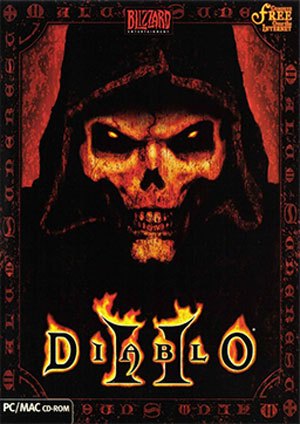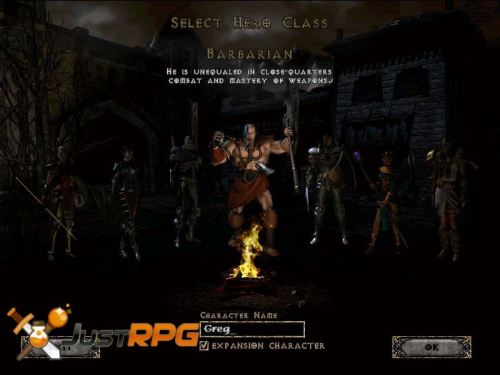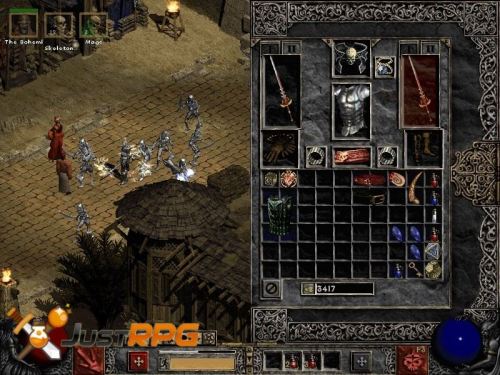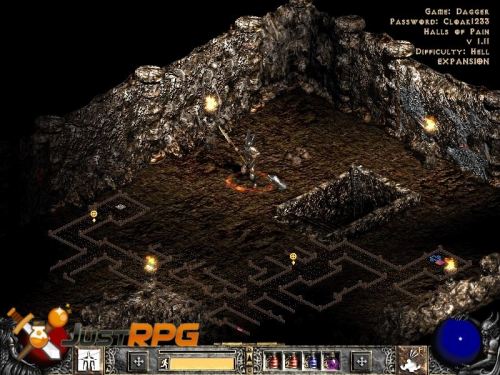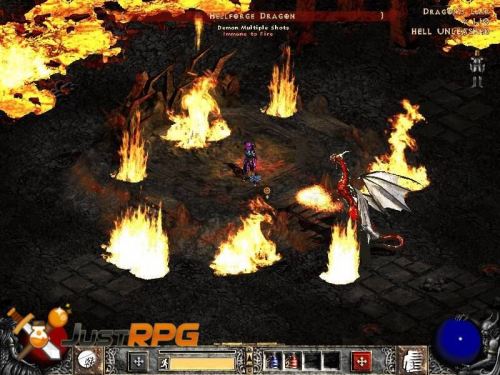Diablo 2
Diablo 2 is an action-RPG for the PC. Its the sequel to the original Diablo, and one of the defining games of the genre. Chose from five distinct characters and save a dark, cursed world that’s under siege by demons. Play alone or with others on Battle.net. Collect epic loot, and slay Diablo and his minions!
| Developer: Blizzard North Publisher: Blizzard Entertainment Release Date: June 29, 2000 Platforms:PC, Mac JustRPG Score: 85% Pros: +Great story and cinematics. +Five distinct characters, each with unique tech trees. +Elaborate random item generator makes for epic looting. +Team up with others or battle against them online via Battle.Net +Randomized maps, multiple characters, and online features all add replay value. +High quality, varied sound track. Cons: -Combat can get repetitive. -Limited replay value in singleplayer. -Many monster designs are re-used over and over again. |
Diablo 2 Overview
Diablo 2 follows up on the original with the Lord of Terror once again being the chief villain. This game is an action RPG fan’s dream come true. There are five original characters, each with three distinct skill trees available including the Paladin, Amazon, Necromancer, Barbarian, and Sorcerer. The main story is broken into 4 ‘acts’, each with a powerful boss waiting at the end of a series of quests. But what has made Diablo 2 a timeless classic is its random item generator and huge loot tables. Blizzard continued to support the game years after its release, adding new items and bug fixes along the way. The ability to play online via battle.net has made Diablo 2 one of the most popular PC games years after its initial release. An expansion titled Diablo 2: Lord of Destruction was released in 2001.
Diablo 2 Screenshots
Diablo 2 Featured Video
[youtube]http://www.youtube.com/watch?v=-4GZdS5E8tE[/youtube]
Diablo 2 Review
By, Nimish Dubey
Sequels are a tricky business, not least when the predecessor has been a staggering success. With Diablo being just that, Blizzard clearly had their hands full when they decided to launch a follow-up in 2000.
And to be fair to them, they haven’t done a bad job of it. The first thing that hits you about the game is its sheer size. There are three CDs, four separate theatres of action (or Acts in Diablospeak), five different characters, thousands of demons, loads of missions and literally dozens of hours of gameplay stacked in here. Playing the game remains as simple and intuitive as ever. All one really needs to wage war against the forces of evil are a few mouse clicks, although the keyboard can be handy at times. Just as in the original, all the maps, items, and monsters are randomized. Therefore, every new game throws up its own combinations and permutations of monsters and items. No point attempting to memorize locations and routes out here.
The central theme of the game remains the same. Just as in the original game (Diablo), you have to assume the role of a character. And this time there are five choices – the Paladin, the Barbarian, the Amazon, the Sorceress, and the Necromancer. Each character has its own flaws and strengths. For instance, the Necromancer can raise an army of the dead to fight for him but is no great shakes at combat himself. Similarly, the Paladin is quite handy at one-to-one combat but gets distinctly uncomfortable when the numbers increase.
The narrative of the game revolves around a wanderer who seems to be obsessed with some evil spirit and releases demons and corrupts souls wherever he sets foot. Your job is to follow him and discover what he is after. You follow a series of quests – which are in most cases, handed out by non-playing characters – as you pursue this stranger.
Naturally, the completion of the quests involves a fair deal of warfare with the powers of darkness and their representatives (demons, skeletons, undead, corrupted rogues, mutant bugs — you name it, Blizzard put it in the game). Along the way, you pick up a number of articles ranging from gold and gems to weapons and wands. You can buy and sell items or repair them – there’s always someone handy enough to provide you the service. Your performance enables you to move up a level from time to time and allot five points among different characteristics to build up your character – strength, dexterity, energy and vitality.
As you progress further in the game, it is revealed that the mysterious wanderer is the hero who killed Diablo in the earlier game. Notwithstanding his defeat (and death!), Diablo has been able to corrupt the hero and is now taking him to rescue his evil brothers, Mephisto and Baal. The pursuit takes you from the Rogue Encampment in Act I to the town of Lut Gholein in Act II , from there to Kurast Docktown in Act III and finally to the Pandemonium Fortress in Act IV , where you confront Diablo. Each Act comprises a series of quests.
While the basic gameplay is the same as in the original (you move by clicking the mouse, attack by clicking on an opponent), Diablo II also comes with some attractive new features. In addition to the normal items, one also now stumbles across socketed items that can be imbued with special qualities by inserting special gems in them. For those wishing to store their weapons, potions and gold, there is a stash. Although the game is spread across vast terrains, you can always cut travelling time by using waypoints that take you to specific locations. And if you ever feel lonely, just hire a mercenary to fight for you. Of course, it does cost a fair penny but then company never came cheap. Other new features include being able to gamble while purchasing an item and the ability to run from one place to another.
Perhaps the most significant change of all is the introduction of the skill tree. Every time you go up a level, you also get an opportunity to learn a new skill or enhance an existing one. Most of the skills are linked to each other, so you often have to follow a chain to learn a particular skill. For instance, if you wish to learn to raise an iron golem, you will first have to learn to raise a clay golem and then a blood golem. With each character commanding a different array of skills, choosing the right combination is one of the most fascinating aspects of the game.
And then there are the cinematics. While the original game had only three cinematics, Diablo II has as many as five, with one before each Act and one at the end. Spectacularly executed, these cinematics flesh out the storyline, giving you an idea of what you are up against and why. The graphics in the game vary from the monotonous to the brilliant (such as the Arcane Sanctuary in Lut Golein) but the sound and music are absolutely stunning. Each of the locales is beautifully presented and there’s lots of exploration to be done before you reach your goal. The music is as good as ever and there are lots and lots of new non-playing characters to interact with.
The characters themselves are quite fascinating and, thankfully, reflect a lot of attitude. In fact, it would be well worth playing each character just to hear what each says in different situations. If I had to pick a favourite, I would go for the Necromancer. His ability to raise creatures allows him to lead a party and he also has a bewildering assortment of spells and curses at his disposal. When my Necromancer came face to face with Diablo, he was accompanied by three skeleton warriors, three mages and a golem. Apart from that, he could also invoke a bone spear, curse Diablo to reduce his damage, deflect the damage back to Diablo, raise a bone wall, and do many other things. Talk of variety! What’s more, the Necromancer radiates attitude and comes up with some marvelous quotes tinged with some rather dry humor.
New characters, new items, new monsters, new skills, easy gameplay – you would think that all those would add up to a really great game. But in the case of Diablo II, they do not. Unfortunately, the game has a lot of niggling features that make it downright tiresome.
Perhaps the biggest shortcoming of the game is that you cannot save it without exiting the game itself. What’s worse, when you restart the game, you find yourself not at the place where you exited, but at the beginning of the Act. To top it all off, all the creatures that you had destroyed the last time around have respawned and are back in business. So unless you quit the game when you were near a waypoint, the chances are the only way you can get back are by hacking and slashing a new path. And if that hasn’t broken your heart, do remember that the mercenaries you had hired before exiting the game might have expired when you restart it. Not much fun that!
Then there are the waypoints themselves. While they are handy to travel, they need to be activated to be functional. And finding them can at times be a right royal pain. They are most inaccessible in Act III in Kurast where thick forests obscure vision. And remember, while your character can travel between different Acts, his mercenaries cannot. So, do not try to hire a rogue in the Rogue Encampment (Act I) and bring her to Lut Gholein (Act II). She won’t make it.
The sheer vastness of the game also serves to weaken the narrative. The storyline more often than not gets lost in all the violence. No matter where you go, your job is simply to kill, kill and keep killing until your quest is fulfilled. In many cases, you enter places like caves and holes and wreak havoc seemingly without any rhyme or reason. Sure, it all builds up your points and helps your character move up a level but all the bashing and chopping begins to grate after a while.
For all the awards it has won and the sales records it has set, the rather stark fact remains that Diablo II is not as good as its predecessor. It has more of everything (one reviewer called it ‘Diablo on steroids’) but loses out on the very core of a role playing game – a good storyline. The game does have some outstanding features but they all fade away in the face of the violence it heaps upon the player. This is a game for those who fancy rivers of blood and piles of skulls.
For all that, it remains remarkably addictive. Once you start playing Diablo II, there’s a fair chance that you will spend an inordinate amount of time on it. You may be appalled at the havoc you wreak or curse in frustration as you search for a waypoint, but you won’t walk away from the game once you have tried it. Which is a bit depressing, as the game is not really all that great. In fact, many times I found myself striving to finish a quest just in order to see the cinematic at the end of the Act!
Playing Diablo had made me feel good as I felt I was waging war against evil. Playing Diablo II made me realize the importance of non-violence. ‘nuff said.
Diablo 2 Videos
Diablo 2 Official Trailer
[youtube]http://www.youtube.com/watch?v=-4GZdS5E8tE[/youtube]

